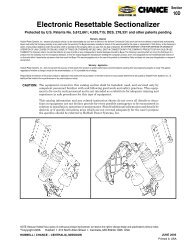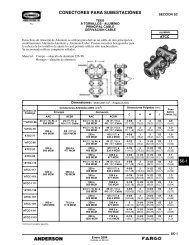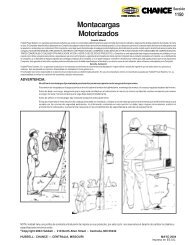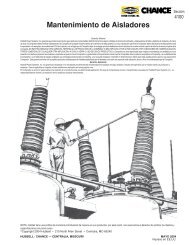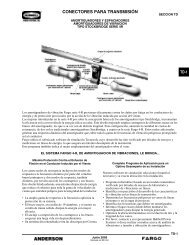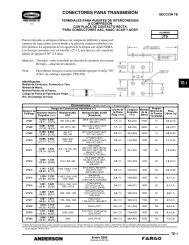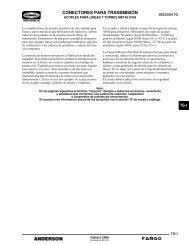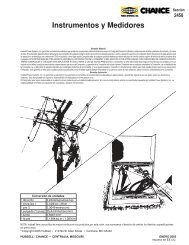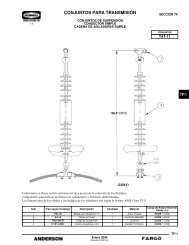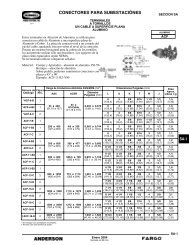Apartarayos PVI PVN - grupo dielec
Apartarayos PVI PVN - grupo dielec
Apartarayos PVI PVN - grupo dielec
You also want an ePaper? Increase the reach of your titles
YUMPU automatically turns print PDFs into web optimized ePapers that Google loves.
30-<br />
POWER SYSTEMS, INC.<br />
® ®<br />
Polymer Housed Arresters (Type <strong>PVI</strong> and <strong>PVN</strong>)<br />
Description<br />
The Type <strong>PVI</strong> & <strong>PVN</strong> arresters contain the same high-quality<br />
metal-oxide varistors used in other Ohio Brass DynaVar<br />
arresters which have operated successfully since 1981.<br />
They have all the MOV advantages such as high temporary<br />
overvoltage capability, contamination resistance, improved<br />
surge-duty capability and excellent protective characteristics.<br />
In the unlikely event of arrester failure, violent fragmentation<br />
of porcelain is eliminated. Instead, the higher available<br />
fault currents may cause splits or tears in the polymer rubber<br />
housing while the internal fiberglass wrap restrains the valve<br />
elements.<br />
Weight is greatly reduced compared to conventional porcelain-housed<br />
designs. Installation is simplified because with<br />
the reduced weight, a patented, single housing design can be<br />
utilized for all arrester voltage ratings.<br />
The small diameter line end terminal hardware permits closer<br />
phase-to-phase and phase-to-ground spacings useful in modern<br />
compact substation designs and on mobile transformer<br />
applications.<br />
ESP Weathershed Material<br />
The arrester housing is made of ESP silicone alloy weathershed<br />
material that has been successful in field operations for<br />
over a decade. The improved ESP housing resists tracking<br />
from surface leakage currents and the housing contour<br />
provides exceptional leakage distance. The housing sections<br />
are mechanically secured to provide a housing suitable for<br />
high pressure hot-washing in locations where contamination<br />
is severe and routine station maintenance includes washing<br />
procedures. Contact Ohio Brass for recommended procedures.<br />
Construction<br />
The housing consists of one or more molded sections which<br />
are mechanically secured into one continuous length for all<br />
arrester voltage ratings. The base of the arrester is equipped<br />
with a factory installed casting which provides the conventional<br />
8.75 inch diameter bolt circle customarily provided with<br />
intermediate and the 10 inch diameter bolt circle for station<br />
class surge arresters.<br />
The varistor column is centered and restrained in alignment<br />
with tightly woven fiberglass filament strands impregnated<br />
with epoxy resin. The interstices between the stranding are<br />
filled with a silicone <strong>dielec</strong>tric compound so the design is free<br />
of air and moisture. The fiberglass stranding construction provides<br />
fault withstand capability in excess of the requirements<br />
of IEEE/ANSI C62.11-1999.<br />
Benefits<br />
The <strong>PVI</strong> and <strong>PVN</strong> arresters have many additional benefits<br />
that are included with the polymer housing.<br />
• A <strong>PVI</strong> or <strong>PVN</strong> arrester unit are less than half the weight<br />
of an equivalent porcelain-housed arrester. This makes<br />
transportation, handling and installation much easier.<br />
• All voltage ratings are of single unit design. Field assembly<br />
of stacked units is not required.<br />
• With a reduced diameter of energized line terminal and<br />
grading rings, the <strong>PVI</strong> and <strong>PVN</strong> arresters reduce space<br />
requirements.<br />
• The polymer housing makes the <strong>PVI</strong> and <strong>PVN</strong> arresters<br />
much safer than porcelain arresters.<br />
• Single-unit, high voltage design provides improved contamination<br />
performance over multi-unit designs.<br />
• Closer spacing — Smaller line end casting and smaller<br />
grading rings allow closer phase-to-phase spacing.<br />
• Increased creepage — Standard units may fulfill high<br />
creep requirements.<br />
• Minimal Internal Atmosphere — Will not “breathe” or leak,<br />
eliminates moisture ingress, a cause of arrester failure.<br />
SEISMIC PERFORMANCE: All <strong>PVI</strong> up to 84kV MCOV, and<br />
all <strong>PVN</strong> up to 115 kV MCOV meet IEEE 693 as of 1997 High<br />
Performance Level. 3.2 g Time History.<br />
Top Cap<br />
Fiberglass Wrap<br />
Coated with Silicone<br />
Dielectric Compound<br />
ESP Housing<br />
MOV Element<br />
Contact Disc<br />
Ground<br />
End<br />
Casting<br />
Section View of Typical <strong>PVI</strong>/<strong>PVN</strong> Arrester<br />
JULY 2006<br />
OHIO BRASS – AIKEN, SC




